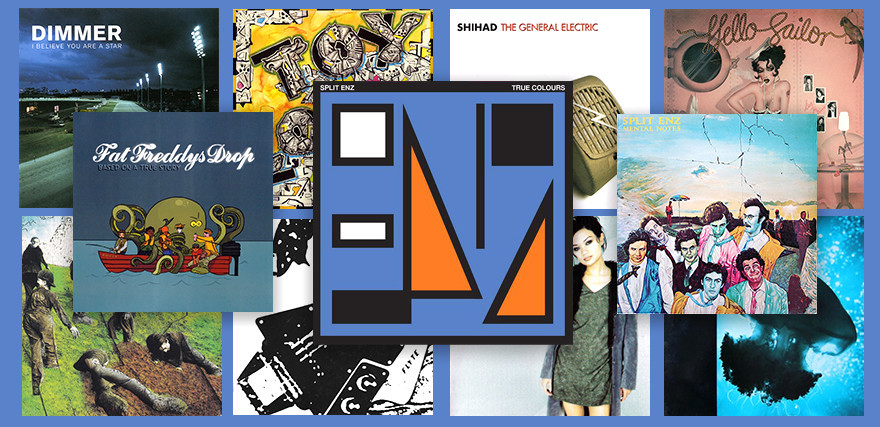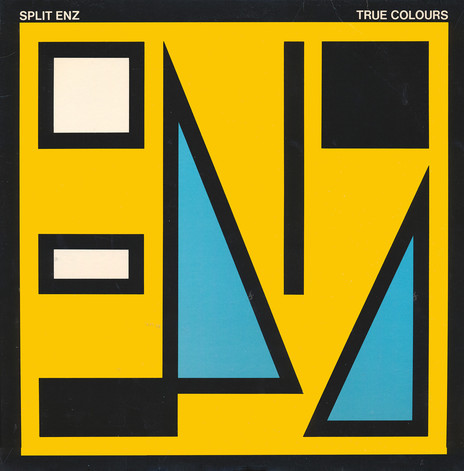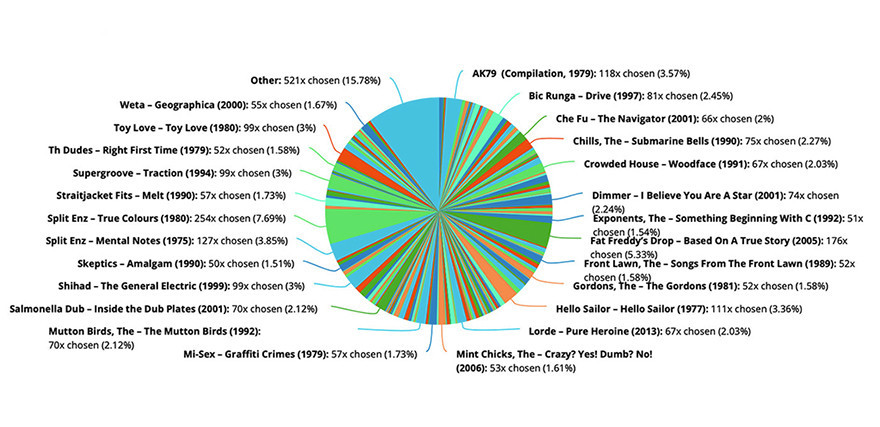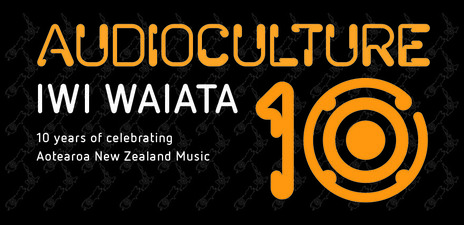
The AudioCulture readers’ poll for a classic New Zealand album generated an enormous number of responses and created a very crowded line-up of candidates. When the poll closed at 11pm on Sunday 28 April, 3301 readers had voted for over 450 different albums.
The winner – drum roll, please – is the 1980 Split Enz album True Colours.

Split Enz - True Colours (1980)
By “classic” we were looking for an album that readers thought was a significant artistic achievement, and one with a lasting impact on New Zealand music – and the public. Readers responded thoughtfully, making the case for a huge variety of albums. Some felt they only needed to say “it’s full of bangers” or “it’s iconic”; one said they didn’t actually like the album they chose, but could see it was a classic.
Inevitably, it becomes a popularity contest, and every poll has its idiosyncrasies. Until relatively recently, pollsters didn’t call mobile phones, which meant the young and transient weren’t included. Internet voting is no good for those who don’t have a computer (which means they’re unlikely to be reading AudioCulture, either).
AudioCulture concentrates on New Zealand popular music history, rather than topical music events and contemporary releases. So it is true that acts that have been around the longest will have an advantage. But the output of New Zealand popular music, its profile and fanbase, have increased exponentially in the 2000s – as reflected in the number of different albums that received votes. Up until the 90s, it was rare for a New Zealand album to have a broad impact, outside an act’s fanbase. Airplay and awareness have increased remarkably in the past couple of decades, but the field is now so crowded it’s harder for an album to be noticed.
The top 10 albums are:
1. Split Enz – True Colours (1980)
2. Fat Freddy’s Drop – Based on A True Story (2005)
3. Split Enz – Mental Notes (1975)
4. Various – AK79 (1979)
5. Hello Sailor – Hello Sailor (1977)
6= Shihad – The General Electric (1999)
6= Toy Love – Toy Love (1980)
6= Supergroove – Traction (1994)
9. Bic Runga – Drive (1997)
10. The Chills – Submarine Bells (1990)
The last big exercise along these lines was the 2001 search for the “top New Zealand song” organised by APRA among its vast songwriting membership and some non-writing musicians, commentators, and producers. As expected, the Finn brothers were prominent in the Top 30, with three songs by Tim, two by Neil, and one they co-wrote. Dave Dobbyn had four, plus one collaboration with Ian Morris.
But, as my dad used to say at Trentham, you can have too many horses in one race. When Barry Jenkin opened the envelope, the winner was Wayne Mason for ‘Nature’. It’s a great song, unquestionably, and this is confirmed by the enjoyment its increased profile has given so many. Crucially, the vote for ‘Nature’ wasn’t split among other Mason creations, and the song had been a hit for two generations, The Fourmyula and The Mutton Birds.
Having so many candidates – as in this poll – also creates a much wider split of the vote. This week a news item mentioned that Donald Trump will likely benefit from the large number of Republicans wanting their party’s nomination to be its presidential candidate. The vast number of New Zealand albums championed by AudioCulture readers means that the votes for the top 20 albums don’t come in big numbers. True Colours received 7.69% of the overall vote, Fat Freddy’s Drop’s Based On a True Story 5.33%, and Split Enz’s Mental Notes 3.85%. Quite quickly, outside the top 20, the percentages diminish to 1% or below.
This is very similar to the way people read stories on AudioCulture. Unlike magazines or newspapers, which are soon repurposed as fire starters or in cat litters, outside our brand-new stories, people are reading the entire site at once (and thankfully, the figures continue to grow overall). This is appropriate considering the timeless, permanent nature of the site.

Of course, it is impossible to compare a heavy metal album with a rap album, a te reo album to vaporwave: that’s not the idea. The poll is about which albums the voters consider to have succeeded on their own artistic terms, and have ended up having a lasting value – and audience.
AudioCulture relies on the goodwill of its readers – for the conversations on social media, for the access and assistance musicians and archival institutions give us – and we wanted to involve the readers in our 10th birthday. Lists of critics’ top 100 albums can be useful but are usually flawed. Critics like to be seen as having superior knowledge and taste; their choices can be a statement of identity as much as an artistic judgement. Critics are often elitists – which can be useful, to open our ears to new experiences. They can cause hype, but also counteract it. They can also lose touch with their followers. This is pop music; many people like to dance or sing along, not hear it in an art gallery.
Grant Smithies described the syndrome with Bangsian humour and exuberance in the introduction to his Soundtrack: 118 Great New Zealand Albums, “a book crammed with blind prejudices, foggy memories, rash declarations, unsubstantiated assertions and, quite probably, lies.”
But popular music is a democratic art. Being popular can mean mediocrity – the lowest common denominator, in craft terms – but at the other end is the highest common denominator. When the best music reaches the most people. (Either side of those denominators are the deviants, but they weren’t a New Zealand band.) Alongside that news item on Trump was UK writer Fiona Maddock discussing a revisionist music biography she’s researching. “Rachmaninov has suffered the fate of the popular: snobbery. Some friends winced when I mentioned what I was writing about.”
In his acclaimed 33.3 book Let’s Talk About Love (Why Other People Have Bad Taste) music critic Carl Wilson – not the Beach Boy – describes cringing at his own cultural snobbery between his teens and his thirties. “How vigilant I was against being taken in – unaware that I was also refusing an invitation out.” Wilson forces himself to listen to the ultimate mass market music (Celine Dion). “A few people have asked me, isn’t life too short to waste time on art you dislike? But lately I feel like life is too short not to.”
He pinpoints “the indie-rock cliché of ‘I used to like that band’ – ie, until people like you liked them.” A long time ago I actually heard a veteran rock critic utter those words.
But also I plead guilty. Much as I loved hearing True Colours on the radio, would I spend pocket money on an Enz gig at the time? It’d be full of tweenies! By chance I’d seen them in the Phil Judd era, with Red Mole supporting, and an audience of actual students in greatcoats and attempted beards. By Time & Tide I was back on the boards.
The story has become legend: Split Enz almost came home with their heads between their legs, conquered by the tyranny of distance, but with True Colours in 1980 the band was revitalised by punk and new wave. Later, it would be called the Thriller phenomenon: all killer, no filler. Although ‘I Got You’ was the only hit single (it even received an airing on Coronation Street –who knew the Rover’s Return had a jukebox?), so many other songs became turntable hits, and then standards.
The album was unavoidable at parties. For a fleeting moment – lobbied by Michael Gudinski – commercial radio was an exhilarating outlet for New Zealand music: ‘Shark Attack’, ‘Nobody Takes Me Seriously’, ‘I Hope I Never’, ‘What’s the Matter With You’, ‘Poor Boy’. It wasn’t just the songs, but the sound: guitar lines that cut through, keyboard sounds swirling all around.
Just 10 months later came ‘One Step Ahead’ and then ‘History Never Repeats’ from Waiata, inspiring Roy Colbert’s astute line: “The two Finns are beatling down the home straight, shoulder to shoulder, hurling diamonds at each other as they run. The race is a delight to watch.” At the last moment, from the outside, what seemed like an answer song came from The Swingers. ‘Counting the Beat’ was an erratic, flighty thoroughbred. As Best Bets would say, Practical Jokers out of Mental Notes.
Horse-racing analogies are, for me, unavoidable, especially for an album recorded in Melbourne. In racing there are stayers (horses that go the distance) and sprinters (best over a short length). ‘Counting the Beat’ was a sprinter, a winner over 1200 furlongs; True Colours stayed the full 3200. And so it was with True Colours in this poll. Out of 3301 votes cast in May, 600 came in the first 24 hours – before any outside media had picked up on the poll. True Colours immediately led the field, and stayed there.
Its lead wasn’t great, and didn’t expand, but it proved insurmountable. One of the surprises of this poll is that Mental Notes – Split Enz’s much more complicated debut – came third. Now there is a stayer which has remained in the hearts of AudioCulture’s older readership. Such an ambitious, risky, flamboyant album. “In those days,” Tim Finn said years later, “if any idea was over 15 seconds long, out it went.” If any New Zealand album is overdue a reverential 180gm vinyl reissue, it’s Mental Notes.
In between, in second place, is Fat Freddy’s Drop’s Based on a True Story, which has been ubiquitous since its release in 2005. Heard over the back fence of every back yard, its opening track ‘Ernie’ has received 33 million plays on Spotify, which only launched in New Zealand in 2012. The band’s countless fans are evangelists:
“It’s suitable for all occasions. Summer day? Great album. Missing summer? Great album. Want to impress foreign guests with quality New Zealand music? Great album. Represents New Zealand vibes.” – Harry
“It has a uniquely New Zealand sound and Fat Freddy’s Drop epitomise the ‘number eight do it yourself’ mentality. I hear something new every time I listen to it.” – Eva
“I don’t even like FFD yet even I think this is the best album.” – Colin
Professional pollsters work hard to eliminate flaws that may privilege or prejudice the results. Being aimed at AudioCulture readers, this poll had a pre-selected audience: committed followers of New Zealand music. Publicity encouraged people outside the core readership – the 25,000 who follow the site on Facebook – to take part. But the votes didn’t suddenly shift to the Telethon mainstream, they became more diverse. If the poll reached those who buy their music outside record stores, eg gas stations – or only listen to Spotify – the responses stayed committed and aware.
For design requirements – and not wanting to overwhelm readers so they didn’t complete the survey – we limited the list of suggestions to about 200 albums, with almost all artists only getting one album as a memory stimulus. Many took up the offer to write in albums that weren’t listed. This boosted the number to an incredible 450 releases (albeit with only a few votes each). Limiting the list worked against prolific solo artists – or did it? Twist is only one of Dave Dobbyn’s albums, and appeared well down the list; there were a few write-in votes for his other albums. But Dobbyn – whose ‘Slice of Heaven’ currently has 50 million plays on Spotify, compared to 30 million for ‘I Got You’ – would fare much better in a singles poll. He is also featured in the results via Th’ Dudes debut album Right First Time, DD Smash’s Cool Bananas, Twist and other write-in albums. All this adds up to a creditable number of votes, albeit split.
Only one vote separates Th’ Dudes’ Right First Time with The Exponent’s No.1 album, the three-times platinum Something Beginning With C. The Exponents are another act remembered for singles. Just ahead of these veterans are Weta and The Mint Chicks. Also, unexpectedly, Songs from the Front Lawn, giving Don McGlashan two entries with The Mutton Birds at No.13 (but Blam Blam Blam seem to have flown the coop). Shayne Carter is represented twice in the top 25, with Dimmer’s I Believe You Are a Star and Straitjacket Fits’ Melt. The hardcore make their presence felt with The Gordons and The Skeptics’ Amalgam (take a bow, Palmerston North).
The list is very white, and very male – which reflects historical power structures, and the lack of diversity in both mainstream and alternative music over many decades. Although Māori have been a leading force in New Zealand popular music for a century, they have been marginalised by radio and, to a lesser extent, television. A few exceptions – Maria Dallas, Allison Durbin, Sandy Edmonds, Shona Laing – show how rare it was for women to be signed to major record labels until the 1990s, with Bic Runga and Jan Hellriegel opening the door. When it comes to punk, it has to be acknowledged that at the time, Māori and women were essentially absent.
This is changing, as we can see by the readership that profiles of Māori and women artists attract on AudioCulture. The artists were always around, just hiding in plain site. Articles on Māori musicians – be they Rob Ruha, Moana Maniapoto, Marlon Williams, Hinewehi Mohi, or Nash Chase – are shared widely, and we are proud that, unusually for a music publication, AudioCulture’s readership is exactly split 50/50 female and male.
I discussed the results with a professional pollster friend. Despite our unsophisticated methodology, getting 3301 reponses out an estimated reach of 25,000 is a significant result, offering reliable data. The population size doesn’t matter – “mostly polls are of 1000 people, so with 3300 your sample is very big,” he said. It means this readers’ poll has a better margin of error than a typical political poll of 1000: +/- 1% rather than +/- 2 or 3%. With such a lengthy list of albums – and especially if it had been longer – readers may have lost focus, but the completed votes (over 90%) suggests not. “If you’d had no list, you’d have had very similar results because the people are so diverse in their tastes.” To get more a detailed idea of biases, more questions would be required, such as age, gender, income. Another factor – unseen here – is how opinion polls can be affected by topical events, for example if there is a documentary that week. “We call these ‘hostages to fortune’ surveys. They trigger a memory, affecting the vote. And politicians know that, so they try to stay in the news, and have good news narratives.”
We were wary of voting campaigns, by band members and their relatives, or fanclubs. There is no evidence this took place: no mention of AudioCulture on the very active Frenz newsgroup of Enz/Crowded House fans, which could have been a significant lobby group. A few votes came in simultaneously for unexpected (or very new) acts, but never more than three or four: it was more of a flag-waving exercise to get noticed. There were some bumps – Lorde at the start, but that quickly evaporated (her Pure Heroine is neck and neck with Crowded House’s Woodface). A small bump for Hello Sailor can be attributed not to its network canvassing for votes – on the last day, the band’s Facebook page recommended voting for Graham Brazier’s first solo album – but to AudioCulture’s own posts. To keep the poll active, and encourage participation, over the month we regularly mentioned many diverse albums that could be contenders. This didn’t have a discernable effect on voting patterns. But five or 10 years on, the next poll won’t be so easy to avoid the trolls and the bots.
What have we learnt? We knew that AudioCulture readers were passionate and knowledgeable about New Zealand music; that’s our raison d’être. We were staggered – and heartened – by the diversity of votes and suggestions. It was meant to be a fun exercise to celebrate 10 years in existence, but it has been enormously informative about where New Zealand music is going, what we need to cover – and how much New Zealand’s attitude towards its music has moved on from its dark, insecure past.
Read more: True Colours and Mental Notes, by Graham Reid
